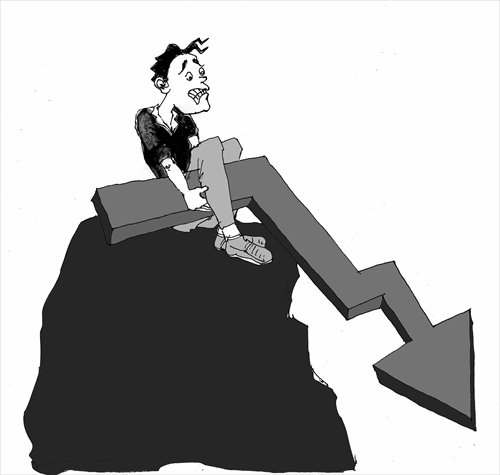HOME >> BUSINESS
How can China’s economy avoid Japan syndrome?
By Yao Yang Source:Global Times Published: 2015-8-31 23:08:01
Regional disparities mean that nation still has growth potential

Illustration: Luo Xuan/GT
Global stock markets have experienced wild volatility in the past week. Many market observers have said that the volatility will be temporary and will not lead to a new financial crisis.
However, China's part in the huge fluctuations should not be ignored. Some overseas analysts have asked whether the swings indicate that China is starting to follow the same path that Japan has been on since the 1970s. The golden age for Japan's economy was a 22-year period between 1951 and the oil shock in 1973. During this period, Japan's average economic growth was 8.8 percent, but after 1973, Japan suffered crashes twice. The first occurred in 1974 when Japan's economy shrank by 4 percent, and its average economic growth over the next 10 years was just 2.1 percent. The second crash occurred in 1993 after the bursting of Japan's asset bubble, and the country's economy has been stuck in the doldrums since then.
The country's experience has been dubbed "the Japan syndrome," whose symptoms are as follows: rapid economic growth in an early phase, resulting from an export-oriented development model and an abundance of cheap labor; but when global demand declines and the cheap labor force is depleted, economic growth slows sharply, accompanied by falling domestic price levels. "The Japan syndrome" happened not only in Japan, but also in other East Asian economies that have experienced high-speed growth.
China's development model has been similar to the one Japan adopted in its golden phase, but China's population is aging faster than that of Japan. Given that the recent global financial crisis was more influential than the oil shock in 1973, people have good reasons to be worried that China might be making the same mistakes as Japan.
China can still increase births by loosening the family-planning policy, and ease the pressure from a declining labor force by improving workers' education and skills and raising the retirement age. It can also develop a new driver for economic growth by encouraging innovation. But these measures cannot fundamentally change the negative impact from China's economic restructuring and its aging population. Properly measured, China's present per capita income and level of education are equivalent to those of Japan in 1970. In Japan's case, in the subsequent 20 years after 1970, even though its education continued to improve and science and technology reached a high level, it did not stop the decline in Japan's economy. Therefore, China should not count too much on education and technological innovation to avoid an economic slowdown.
However, one advantage China has over Japan is that it is a big country - both geographically and in terms of population. From perspectives of population and geographical size, China is equivalent to Europe.
One consequence of being a vast country is that levels of development vary drastically. For example, in terms of per capita GDP, Tianjin is the highest, with a level four times that of Guizhou Province, according to statistics from 2014. And in terms of income distribution, according to statistics from 2012, 10 percent of people with the highest revenue accounted for 35 percent of total revenue, while nearly one-third of Chinese people's revenue did not even reach the equivalent of 2 dollars per day. Such a large revenue gap shows there is still huge growth potential for China's economy.
The European integration process offers a good lesson for China. Around 25 years ago, the income level of countries in Eastern Europe was in the middle in terms of global rankings. In the wake of dramatic changes in Eastern Europe in 1989, the economies of countries in the region even slipped backwards. But after they joined the EU, production and income levels strengthened greatly, and most of the countries in the region are now among the world's high-income countries. This is a typical example of the convergence theory in economics taking effect. The theory holds that with the implementation of the same economic policies, poorer economies' per capita income will tend to grow at a faster pace than in richer countries.
Therefore, we have reasons to keep faith in China's economic growth. At the national level, China is in urgent need of a plan to boost inland economies so as to promote industrial development and urbanization in Northwest and Central China, with the goal of income in these regions equaling that of coastal provinces in East China in the next 20 years. To realize the goal, annual average economic growth in Northwest and Central China will have to be higher by 3 to 4 percent than in East China. As a result, even if growth in coastal provinces falls to between 5 and 6 percent, the overall domestic average growth rate can remain at around 7 percent.
The author is dean of the National School of Development, Peking University. bizopinion@globaltimes.com.cn
Posted in: Expert assessment